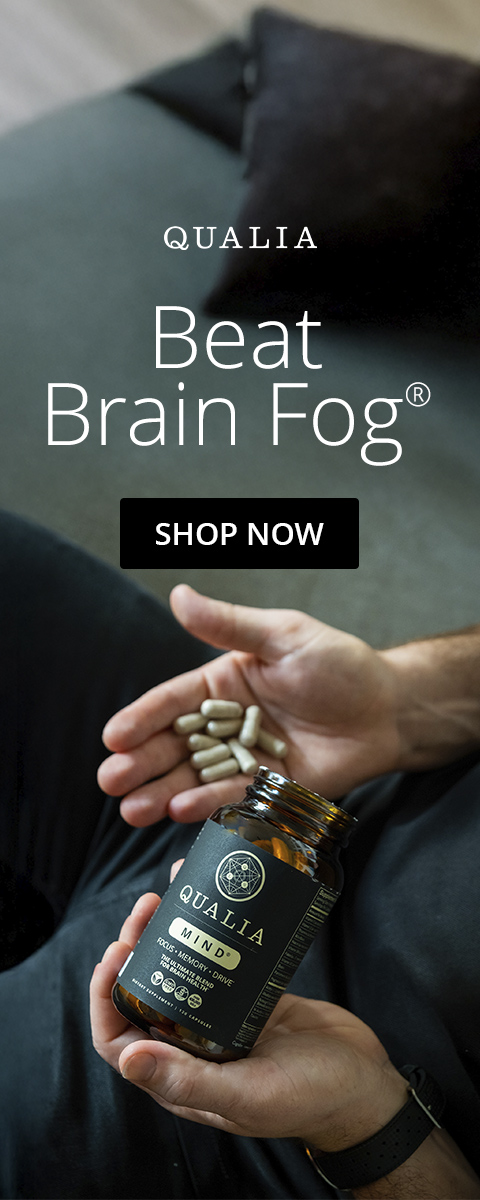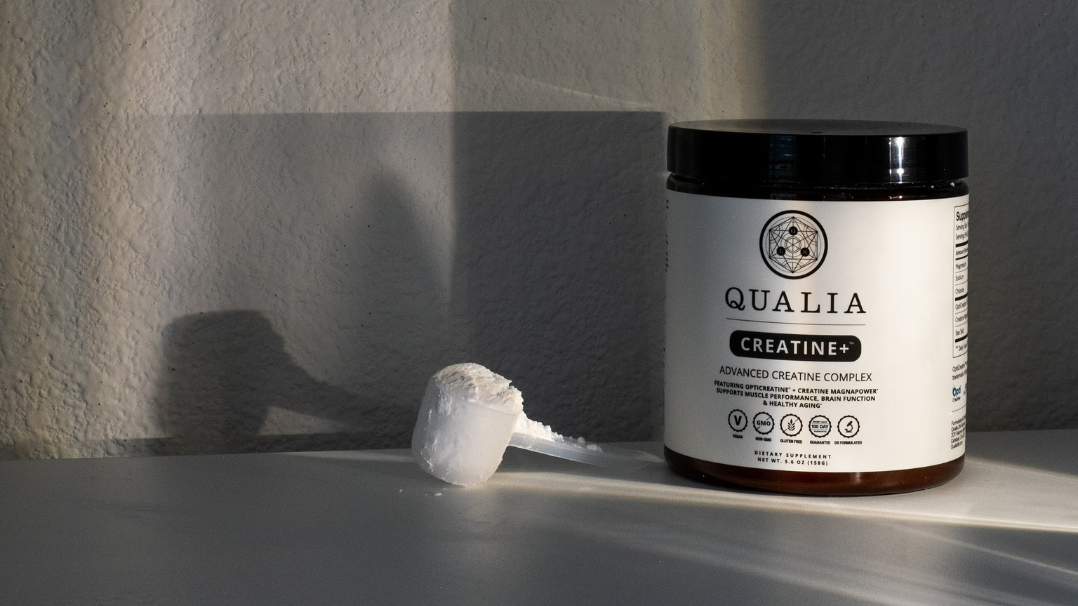What are Brain Supplements?
Brain supplements are bioactive substances, either natural or synthetic, that promote brain health by supporting the functional and structural status of the brain. By doing so, brain supplements can support the many dimensions of brain activity, including higher brain functions such as cognitive performance, mental energy, behavior, mood, and sociability. Substances that support these capacities are also known as nootropics.*
Brain supplements can support brain health and function by targeting processes such as:
- neurotransmitter synthesis and signaling;*
- neuronal communication, synaptic transmission, and synaptic plasticity;*
- cerebral blood flow and metabolism;*
- neuronal structure and structural plasticity;*
- neuroprotection, antioxidant defenses, and cerebral detoxification;*
- sleep quality and nighttime physiology.*
What Are the Best Brain Supplements?
Many brain supplements are simply molecules that are part of the brain’s natural physiology such as vitamins, minerals, amino acids, or phospholipids; some are precursors or intermediaries in biosynthetic pathways that produce neurotransmitters or other important brain molecules; and others are botanical extracts, mushrooms, or other dietary substances that can influence signaling pathways, metabolic reactions, stress responses, or other processes that contribute to proper brain function.
Here are some nootropic examples:
B Vitamins
B vitamins are a group of eight essential vitamins with crucial roles in cellular metabolism and energy production. The eight B vitamins are thiamine (B1), riboflavin (B2), niacin (B3), pantothenic acid (B5), pyridoxine (B6), biotin (B7), folate (B9), and cobalamin (B12). Every B vitamin is either a cofactor (i.e., required for enzyme activity) or a precursor for a cofactor for a key metabolic process. For this reason, B vitamins are essential for the function of every organ. But given the brain’s high metabolic demands, maintaining healthy levels of all B vitamins is particularly important for brain health. Furthermore, some B vitamins are used as cofactors in metabolic pathways that synthesize neurotransmitters and other molecules that are fundamental for brain function.*

Magnesium
Magnesium is an essential mineral with crucial roles in the human body. In the brain, magnesium is used in all major pathways of cellular energy metabolism and is necessary for neurotransmitter synthesis, synaptic transmission, neuroplasticity, and neuroprotection, all of which are essential for brain health and cognitive function [1]. Therefore, maintaining healthy brain levels of magnesium is critical for cognitive health, particularly as we age [2,3]. Clinical studies have indicated that people consuming diets rich in magnesium maintain better cognitive performance with aging [4,5].* To learn more about why magnesium is critical for the brain, we recommend reading Magnesium for Brain Health: Why Magnesium Is Crucial.

Choline
Choline is part of the structure of two very important brain molecules: the neurotransmitter acetylcholine, which supports attention, concentration, mental focus, and memory [6,7], and the phospholipid phosphatidylcholine, which is a component of cell membranes needed for healthy cell function [8]. Choline can be supplemented in different forms. Two of those forms—alpha-GPC and citicoline (i.e., CDP-choline)—are considered nootropics because they are able to increase brain choline levels, act as building blocks for acetylcholine, and support choline-dependent neurotransmission [9–12]. They also support phosphatidylcholine biosynthesis and can thus be used to support the structure and function of cell membranes. Furthermore, phosphatidylcholine is the main form of choline in the body and brain and serves as a reservoir or pool of choline that can be mobilized for acetylcholine synthesis [6,11,13–15]. Clinical studies have shown that both alpha-GPC and citicoline may support cognitive function [16–24].*

Phosphatidylserine
Phosphatidylserine is a phospholipid found in the internal layer of cell membranes where it supports the function and activity of receptors, enzymes, ion channels, and signaling molecules. Phosphatidylserine is one of the major membrane phospholipids in the brain, accounting for around 13% of the phospholipids in the human cerebral cortex [25]. Phosphatidylserine has been used in several clinical studies for the support of cognitive function where it was shown to promote memory, cognitive performance, and general cognitive health, particularly in older individuals [26–33].*

Lutein and Zeaxanthin
Lutein and zeaxanthin are two carotenoids naturally found in the human body, where they have several important roles. Lutein and zeaxanthin, along with another carotenoid called meso-zeaxanthin, are called macular pigments because they accumulate in the macula, an area near the center of the retina responsible for sharp, clear, central vision. They have a key role in filtering blue light and in maintaining eye health and healthy vision [34–37]. Lutein and zeaxanthin also accumulate in the brain and are among the predominant carotenoids in the nervous system (along with β-cryptoxanthin), with lutein alone accounting for over one third of brain carotenoids. Brain levels of lutein and zeaxanthin have been associated with healthy cognitive function [38,39]. Supplementation with macular carotenoids has been shown to support memory, executive function, and other aspects of cognitive performance [40–47].*

Ginkgo Biloba
Ginkgo biloba is one of the most widely used and researched herbs for brain health. Ginkgo has been used in Traditional Chinese Medicine for several hundred years. Ginkgo contains several bioactive substances whose actions support neurotransmitter systems, neuroplasticity, neuroprotective functions, and promote healthy vascular function and cerebral blood flow [48–50]. In clinical studies, Ginkgo was shown to support cognitive health, memory, attention, executive function, and mood [51–66].*

Lion’s Mane
Lion’s Mane (Hericium erinaceus) is an edible mushroom that supports neuroprotective functions and brain health [67]. It has been used in traditional Chinese medicine for centuries. In preclinical studies, Lion’s Mane was shown to support brain structure, namely dendrite growth and myelination, both of which contribute to the efficiency of neuronal communication [68–70]. In a clinical study with older individuals, Lion’s Mane helped to maintain neural organization and healthy brain structure [71].*

Celastrus paniculatus
Celastrus paniculatus is a herb with a long history of traditional use as a brain tonic to support mental acuity, memory and intellect and to alleviate mental fatigue [72]. Because of these traditional uses, Celastrus is also known as “the intellect tree.” Celastrus supports antioxidant defenses, neuroprotective functions, and neurotransmitter systems [73–83]. These properties may underlie its support of cognitive function observed in preclinical research [80–84].*

Caffeine
Caffeine is a central nervous system stimulant that promotes wakefulness, arousal, and resistance to mental fatigue. Clinical studies have shown that caffeine supports several aspects of cognitive performance, including alertness, attention, reaction time, information processing, executive function, reasoning, and even creative thinking, all of which contribute to our capacity for mental work [85–92]. However, it's important to limit caffeine intake because responses to caffeine tend to follow an hormetic curve, meaning that too much caffeine may actually hinder performance. *

L-Theanine
L-theanine is an amino acid with calming actions found in highest amounts in green and black tea. L-theanine promotes alpha brain waves (α-waves), which are regarded as a marker of relaxation [93,94]. It is used as a nootropic because it supports relaxed alertness, focused attention, reaction times, and a calm sense of mental energy [95–100]. L-theanine is frequently used in combination with caffeine in nootropic stacks, because it helps to balance its stimulating action. Together, L-theanine and caffeine support alertness, attention, mood, and cognition [101–105].*
Combining Brain Supplements for Comprehensive Brain Support
All these compounds and ingredients we mentioned have specific actions that contribute to specific aspects of brain function and cognition. On their own, they’re already a helpful tool to support brain health. But when brought together, these ingredients can complement and elevate each other's actions. The trick is knowing how to combine them. That requires knowledge about neurophysiology and neurobiology and about the mechanisms of action of each compound. And we have that knowledge.
So if you’re looking for a supplement that combines brain essential nutrients including vitamins, minerals, amino acids, choline donors, and botanical extracts that support brain health and cognitive performance, look no further. Qualia Mind was formulated taking into account the individual actions of its ingredients in supporting brain health, but also how they complement each other and work together for a comprehensive support of cognitive function—what we call a whole system upgrade.* Learn more about the science behind Qualia Mind in our article Qualia Mind: The Building of a Nootropic Stack. We invite you to experience Qualia Mind.
*These statements have not been evaluated by the Food and Drug Administration. This product is not intended to diagnose, treat, cure, or prevent any disease.
References
[1]J.A.M. Maier, L. Locatelli, G. Fedele, A. Cazzaniga, A. Mazur, Int. J. Mol. Sci. 24 (2022).
[2]M. Barbagallo, L.J. Dominguez, Curr. Pharm. Des. 16 (2010) 832–839.
[3]M. Barbagallo, N. Veronese, L.J. Dominguez, Nutrients 13 (2021).
[4]N. Cherbuin, R. Kumar, P.S. Sachdev, K.J. Anstey, Front. Aging Neurosci. 6 (2014) 4.
[5]M. Ozawa, T. Ninomiya, T. Ohara, Y. Hirakawa, Y. Doi, J. Hata, K. Uchida, T. Shirota, T. Kitazono, Y. Kiyohara, J. Am. Geriatr. Soc. 60 (2012) 1515–1520.
[6]G.B. Weiss, Life Sci. 56 (1995) 637–660.
[7]S.K. Fisher, S. Wonnacott, in: S.T. Brady, G.J. Siegel, R.W. Albers, D.L. Price (Eds.), Basic Neurochemistry (Eighth Edition), Academic Press, New York, 2012, pp. 258–282.
[8]J.N. van der Veen, J.P. Kennelly, S. Wan, J.E. Vance, D.E. Vance, R.L. Jacobs, Biochim. Biophys. Acta Biomembr. 1859 (2017) 1558–1572.
[9]M. Trabucchi, S. Govoni, F. Battaini, Farmaco Sci. 41 (1986) 325–334.
[10]C.M. Lopez, S. Govoni, F. Battaini, S. Bergamaschi, A. Longoni, C. Giaroni, M. Trabucchi, Pharmacol. Biochem. Behav. 39 (1991) 835–840.
[11]S. Sigala, A. Imperato, P. Rizzonelli, P. Casolini, C. Missale, P. Spano, Eur. J. Pharmacol. 211 (1992) 351–358.
[12]N. Canal, Others, Le Basi Raz Ter 23 (1993) 102.|
[13]J. Agut, E. Font, A. Sacristán, J.A. Ortiz, Arzneimittelforschung 33 (1983) 1048–1050.
[14]P. Galletti, M. De Rosa, M.G. Cotticelli, A. Morana, R. Vaccaro, V. Zappia, J. Neurol. Sci. 103 Suppl (1991) S19–25.
[15]I.H. Ulus, R.J. Wurtman, C. Mauron, J.K. Blusztajn, Brain Res. 484 (1989) 217–227.
[16]L. Parnetti, F. Mignini, D. Tomassoni, E. Traini, F. Amenta, J. Neurol. Sci. 257 (2007) 264–269.
[17]F. Amenta, A. Carotenuto, A.M. Fasanaro, R. Rea, E. Traini, J. Neurol. Sci. 322 (2012) 96–101.
[18]L. Parnetti, F. Amenta, V. Gallai, Mech. Ageing Dev. 122 (2001) 2041–2055.
[19]X.A. Alvarez, R. Mouzo, V. Pichel, P. Perez, M. Laredo, L. Fernandez-Novoa, L. Corzo, R. Zas, M. Alcaraz, J.J. Secades, Others, Methods Find. Exp. Clin. Pharmacol. 21 (1999) 633.
[20]P.A. Spiers, D. Myers, G.S. Hochanadel, H.R. Lieberman, R.J. Wurtman, Arch. Neurol. 53 (1996) 441–448.
[21]X.A. Alvarez, M. Laredo, D. Corzo, L. Fernández-Novoa, R. Mouzo, J.E. Perea, D. Daniele, R. Cacabelos, Methods Find. Exp. Clin. Pharmacol. 19 (1997) 201–210.
[22]V. Knott, S. de la Salle, J. Choueiry, D. Impey, D. Smith, M. Smith, E. Beaudry, S. Saghir, V. Ilivitsky, A. Labelle, Pharmacol. Biochem. Behav. 131 (2015) 119–129.
[23]E. McGlade, A. Locatelli, J. Hardy, T. Kamiya, M. Morita, K. Morishita, Y. Sugimura, D. Yurgelun-Todd, FNS 03 (2012) 769–773.
[24]E. McGlade, A.M. Agoston, J. DiMuzio, M. Kizaki, E. Nakazaki, T. Kamiya, D. Yurgelun-Todd, J. Atten. Disord. 23 (2019) 121–134.|
[25]H.-Y. Kim, B.X. Huang, A.A. Spector, Prog. Lipid Res. 56 (2014) 1–18.
[26]Y. Richter, Y. Herzog, Y. Lifshitz, R. Hayun, S. Zchut, Clin. Interv. Aging 8 (2013) 557–563.
[27]A. Kato-Kataoka, M. Sakai, R. Ebina, C. Nonaka, T. Asano, T. Miyamori, J. Clin. Biochem. Nutr. 47 (2010) 246–255.
[28]S. Hirayama, K. Terasawa, R. Rabeler, T. Hirayama, T. Inoue, Y. Tatsumi, M. Purpura, R. Jäger, J. Hum. Nutr. Diet. 27 Suppl 2 (2014) 284–291.
[29]T. Cenacchi, T. Bertoldin, C. Farina, M.G. Fiori, G. Crepaldi, Aging 5 (1993) 123–133.
[30]M. Maggioni, G.B. Picotti, G.P. Bondiolotti, A. Panerai, T. Cenacchi, P. Nobile, F. Brambilla, Acta Psychiatr. Scand. 81 (1990) 265–270.
[31]T.H. Crook, J. Tinklenberg, J. Yesavage, W. Petrie, M.G. Nunzi, D.C. Massari, Neurology 41 (1991) 644–649.
[32]S. Schreiber, O. Kampf-Sherf, M. Gorfine, D. Kelly, Y. Oppenheim, B. Lerer, Isr. J. Psychiatry Relat. Sci. 37 (2000) 302–307.
[33]M.I. Moré, U. Freitas, D. Rutenberg, Adv. Ther. 31 (2014) 1247–1262.
[34]L. Ma, X.-M. Lin, Z.-Y. Zou, X.-R. Xu, Y. Li, R. Xu, Br. J. Nutr. 102 (2009) 186–190.
[35]J. Kvansakul, M. Rodriguez-Carmona, D.F. Edgar, F.M. Barker, W. Köpcke, W. Schalch, J.L. Barbur, Ophthalmic Physiol. Opt. 26 (2006) 362–371.
[36]R. Liu, T. Wang, B. Zhang, L. Qin, C. Wu, Q. Li, L. Ma, Invest. Ophthalmol. Vis. Sci. 56 (2014) 252–258.
[37]J.M. Nolan, J. Loughman, M.C. Akkali, J. Stack, G. Scanlon, P. Davison, S. Beatty, Vision Res. 51 (2011) 459–469.
[38]L. Sauer, B. Li, P.S. Bernstein, Annu. Rev. Nutr. 39 (2019) 95–120.
[39]E.J. Johnson, Nutr. Rev. 72 (2014) 605–612.
[40]N.T. Stringham, P.V. Holmes, J.M. Stringham, Physiol. Behav. 211 (2019) 112650.
[41]B.R. Hammond Jr, L.S. Miller, M.O. Bello, C.A. Lindbergh, C. Mewborn, L.M. Renzi-Hammond, Front. Aging Neurosci. 9 (2017) 254.
[42]R. Power, R.F. Coen, S. Beatty, R. Mulcahy, R. Moran, J. Stack, A.N. Howard, J.M. Nolan, J. Alzheimers. Dis. 61 (2018) 947–961.
[43]L.M. Renzi-Hammond, E.R. Bovier, L.M. Fletcher, L.S. Miller, C.M. Mewborn, C.A. Lindbergh, J.H. Baxter, B.R. Hammond, Nutrients 9 (2017).
[44]C.M. Mewborn, C.A. Lindbergh, T.L. Robinson, M.A. Gogniat, D.P. Terry, K.R. Jean, B.R. Hammond, L.M. Renzi-Hammond, L.S. Miller, Nutrients 10 (2018).
[45]E.R. Bovier, L.M. Renzi, B.R. Hammond, PLoS One 9 (2014) e108178.
[46]E.R. Bovier, B.R. Hammond, Arch. Biochem. Biophys. 572 (2015) 54–57.
[47]S.A. Ceravolo, B.R. Hammond, W. Oliver, B. Clementz, L.S. Miller, L.M. Renzi-Hammond, Mol. Nutr. Food Res. 63 (2019) e1801051.
[48]F.V. DeFeudis, Pharmacopsychiatry 36 Suppl 1 (2003) S2–7.
[49]A. Mashayekh, D.L. Pham, D.M. Yousem, M. Dizon, P.B. Barker, D.D.M. Lin, Neuroradiology 53 (2011) 185–191.
[50]R.F. Santos, J.C. Galduróz, A. Barbieri, M.L. Castiglioni, L.Y. Ytaya, O.F. Bueno, Pharmacopsychiatry 36 (2003) 127–133.
[51]D.O. Kennedy, P.A. Jackson, C.F. Haskell, A.B. Scholey, Hum. Psychopharmacol. 22 (2007) 559–566.
[52]U. Rigney, S. Kimber, I. Hindmarch, Phytother. Res. 13 (1999) 408–415.
[53]R. Kaschel, Phytomedicine 18 (2011) 1202–1207.
[54]Z. Subhan, I. Hindmarch, Int. J. Clin. Pharmacol. Res. 4 (1984) 89–93.
[55]J.A. Mix, W.D. Crews Jr, Hum. Psychopharmacol. 17 (2002) 267–277.
[56]D.O. Kennedy, A.B. Scholey, K.A. Wesnes, Psychopharmacology 151 (2000) 416–423.
[57]S. Elsabagh, D.E. Hartley, O. Ali, E.M. Williamson, S.E. File, Psychopharmacology 179 (2005) 437–446.
[58]C. Stough, J. Clarke, J. Lloyd, P.J. Nathan, Int. J. Neuropsychopharmacol. 4 (2001) 131–134.
[59]R.B. Silberstein, A. Pipingas, J. Song, D.A. Camfield, P.J. Nathan, C. Stough, Evid. Based. Complement. Alternat. Med. 2011 (2011) 164139.
[60]J.A. Mix, W.D. Crews Jr, J. Altern. Complement. Med. 6 (2000) 219–229.
[61]P.L. Le Bars, M.M. Katz, N. Berman, T.M. Itil, A.M. Freedman, A.F. Schatzberg, JAMA 278 (1997) 1327–1332.
[62]O. Napryeyenko, I. Borzenko, GINDEM-NP Study Group, Arzneimittelforschung 57 (2007) 4–11.
[63]R. Ihl, M. Tribanek, N. Bachinskaya, GOTADAY Study Group, Pharmacopsychiatry 45 (2012) 41–46.
[64]H. Woelk, K.H. Arnoldt, M. Kieser, R. Hoerr, J. Psychiatr. Res. 41 (2007) 472–480.
[65]R. Hoerr, Pharmacopsychiatry 36 Suppl 1 (2003) S56–61.
[67]I.-C. Li, L.-Y. Lee, T.-T. Tzeng, W.-P. Chen, Y.-P. Chen, Y.-J. Shiao, C.-C. Chen, Behav. Neurol. 2018 (2018) 5802634.
|[68]P.-L. Lai, M. Naidu, V. Sabaratnam, K.-H. Wong, R.P. David, U.R. Kuppusamy, N. Abdullah, S.N.A. Malek, Int. J. Med. Mushrooms 15 (2013) 539–554.
[69]S. Samberkar, S. Gandhi, M. Naidu, K.-H. Wong, J. Raman, V. Sabaratnam, Int. J. Med. Mushrooms 17 (2015) 1047–1054.
[70]E.V. Kolotushkina, M.G. Moldavan, K.Y. Voronin, G.G. Skibo, Fiziol. Zh. 49 (2003) 38–45.
[71]I.-C. Li, H.-H. Chang, C.-H. Lin, W.-P. Chen, T.-H. Lu, L.-Y. Lee, Y.-W. Chen, Y.-P. Chen, C.-C. Chen, D.P.-C. Lin, Front. Aging Neurosci. 12 (2020) 155.
[72]N. Arora, S.P. Rai, Int. J. Pharma Bio Sci. 3 (2012) 290–303.
[73]J. Malik, M. Karan, R. Dogra, Pharm. Biol. 55 (2017) 980–990.
[74]P.B. Godkar, R.K. Gordon, A. Ravindran, B.P. Doctor, Phytomedicine 13 (2006) 29–36.
[76]M. Gattu, K.L. Boss, A.V. Terry Jr, J.J. Buccafusco, Pharmacol. Biochem. Behav. 57 (1997) 793–799.
[77]R. Valecha, D. Dhingra, Basic Clin Neurosci 7 (2016) 49–56.
[78]M. Chakrabarty, P. Bhat, S. Kumari, A. D’Souza, K.L. Bairy, A. Chaturvedi, A. Natarajan, M.K.G. Rao, S. Kamath, J. Pharmacol. Pharmacother. 3 (2012) 161–171.
[79]P.B. Godkar, R.K. Gordon, A. Ravindran, B.P. Doctor, J. Ethnopharmacol. 93 (2004) 213–219.
[80]M.H.V. Kumar, Y.K. Gupta, Phytomedicine 9 (2002) 302–311.
[81]M. Bhanumathy, M.S. Harish, H.N. Shivaprasad, G. Sushma, Pharm. Biol. 48 (2010) 324–327.
[82]K. Nalini, K.S. Karanth, A. Rao, A.R. Aroor, J. Ethnopharmacol. 47 (1995) 101–108.
[83]V. Bhagya, T. Christofer, B.S. Shankaranarayana Rao, Indian J. Pharmacol. 48 (2016) 687–693.
[84]S.B. Raut, R.R. Parekar, K.S. Jadhav, P.A. Marathe, N.N. Rege, Anc. Sci. Life 34 (2015) 130–133.
[85]T.M. McLellan, J.A. Caldwell, H.R. Lieberman, Neurosci. Biobehav. Rev. 71 (2016) 294–312.
[86]A. Smith, Food Chem. Toxicol. 40 (2002) 1243–1255.
[87]S.J.L. Einöther, T. Giesbrecht, Psychopharmacology 225 (2013) 251–274.
[88]J. Lanini, J.C.F. Galduróz, S. Pompéia, Hum. Psychopharmacol. 31 (2016) 29–43.
[89]A. Nehlig, J. Alzheimers. Dis. 20 Suppl 1 (2010) S85–94.
[90]C.H.S. Ruxton, Nutr. Bull. 33 (2008) 15–25.
[91]K. Soar, E. Chapman, N. Lavan, A.S. Jansari, J.J.D. Turner, Appetite 105 (2016) 156–163.
[92]M.J. Jarvis, Psychopharmacology 110 (1993) 45–52.
[93]L.R. Juneja, D.-C. Chu, T. Okubo, Y. Nagato, H. Yokogoshi, Trends Food Sci. Technol. 10 (1999) 199–204.
[94]C.H. Song, J.H. Jung, J.S. Oh, K.S. Kim, Korean Journal of Nutrition 36 (2003) 918–923.
[95]A. Higashiyama, H.H. Htay, M. Ozeki, L.R. Juneja, M.P. Kapoor, J. Funct. Foods 3 (2011) 171–178.
[96]S.-K. Park, I.-C. Jung, W.K. Lee, Y.S. Lee, H.K. Park, H.J. Go, K. Kim, N.K. Lim, J.T. Hong, S.Y. Ly, S.S. Rho, J. Med. Food 14 (2011) 334–343.
[97]S. Hidese, S. Ogawa, M. Ota, I. Ishida, Z. Yasukawa, M. Ozeki, H. Kunugi, Nutrients 11 (2019).
[98]M. Gomez-Ramirez, B.A. Higgins, J.A. Rycroft, G.N. Owen, J. Mahoney, M. Shpaner, J.J. Foxe, Clin. Neuropharmacol. 30 (2007) 25–38.
[99]A.C. Nobre, A. Rao, G.N. Owen, Asia Pac. J. Clin. Nutr. 17 Suppl 1 (2008) 167–168.
[100]D.J. White, S. de Klerk, W. Woods, S. Gondalia, C. Noonan, A.B. Scholey, Nutrients 8 (2016).
[101]C.F. Haskell, D.O. Kennedy, A.L. Milne, K.A. Wesnes, A.B. Scholey, Biol. Psychol. 77 (2008) 113–122.
[102]S.J.L. Einöther, V.E.G. Martens, J.A. Rycroft, E.A. De Bruin, Appetite 54 (2010) 406–409.
[103]T. Giesbrecht, J.A. Rycroft, M.J. Rowson, E.A. De Bruin, Nutr. Neurosci. 13 (2010) 283–290.
[104]G.N. Owen, H. Parnell, E.A. De Bruin, J.A. Rycroft, Nutr. Neurosci. 11 (2008) 193–198.
[105]C.N. Kahathuduwa, T.L. Dassanayake, A.M.T. Amarakoon, V.S. Weerasinghe, Nutr. Neurosci. 20 (2017) 369–377.











Marilee Coles-Ritchie